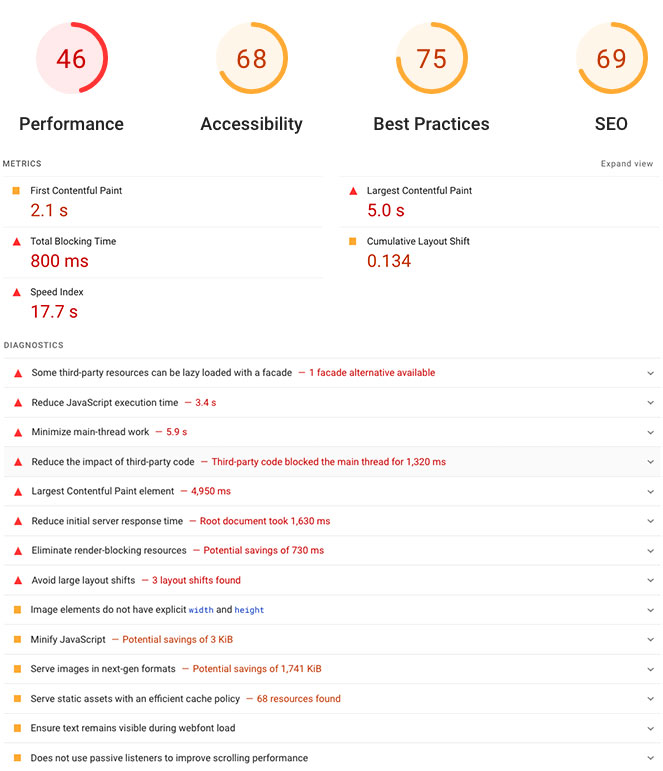Over the past six months, we have completed website audits for businesses all over Australia, from professional services to e-commerce stores and membership-based organisations. We have met with business owners and offered specific recommendations for each of their businesses. While every website we reviewed was unique, the same issues kept appearing across multiple industries.
One of the most frequent problems was design and usability. Some websites had a modern look, but many lacked a focus on user experience. Cluttered pages, overwhelming amounts of text, and confusing navigation structures made it difficult for visitors to find what they needed.
On the technical side, slow-loading sites and SEO issues were common, with many websites unknowingly hurting their search rankings due to poor optimisation.
Through these audits, it became clear that many business owners still see their website as a “set and forget” asset. Something they build once and leave untouched for years.
In reality, a website is more like a physical store or office. Without regular updates, maintenance, and improvements, it gradually becomes outdated, ineffective, and frustrating for visitors. In some cases, the asset transform into a liability.
During these audits we focus on 5 key areas:
- Technical performance: performance, script and data compression, etc.
- Conversions: whether the site is effectively turning visitors into customers.
- Design and usability: navigation, accessibility, and overall user experience.
- SEO: how well the site is optimised for search engines.
- Security: protecting the site from potential threats
In this blog post, we’ll focus on the first three: technical performance, conversions and design.
As with any business audit, there’s no substitute for having a professional team use specialised tools to perform a thorough assessment. However, we’ll also provide simple ways to conduct an in-house audit using free tools and highlight key areas to discuss with your web design agency or internal IT team.
Technical Performance
A slow or poorly performing website frustrates visitors, and can will hurt your search rankings. Several factors contribute to technical performance, but the most important ones to check include:
- Page speed. Users will likely leave if a page takes more than a few seconds to load. Slow load times are often caused by large images, too many plugins used, or a poor hosting provider.
- Mobile responsiveness. A website should adapt seamlessly to different screen sizes. If users have to zoom in to read text, click on a link or scroll left and right on their phones, the site isn’t mobile-friendly.
- Broken links and errors. Pages returning 404 errors or leading to dead links create a poor user experience and also hurt SEO.
- Hosting quality. We have said this many times. Cheap, shared hosting can slow down a site, especially during traffic spikes. A premium cloud-based hosting solution ensures better speed, security, and uptime.
- Image optimisation. Large, uncompressed images can significantly slow down a website. Compressing images and using modern formats while maintaining quality can make a big difference.
The good news is that there is a lot you can do in-house in this area. The easiest way is to test the site yourself on different devices and different internet connections. You can quickly see if your website is slow or mobile-friendly or if images take ages to load.
Make sure you test this using different devices or an incognito window. That way, the tests won’t be affected by cache or your previous browsing history.
If you want a more objective result for this test, a few free tools are available, but perhaps the best one is Google PageSpeed Insights. This tool will not only cover performance but will also evaluate SEO, accessibility and best practices. Remember, you don’t necessarily need 100% in all areas. In most cases, scores above 80% are good enough for most businesses.

Conversions
A website isn’t just about looking good. It needs to drive results, whether that’s generating leads, making sales, or encouraging users to take action. If visitors land on your site but leave without engaging, there could be conversion issues.
We have mentioned the importance of optimising websites for conversions in previous blogs, but here are a few key areas to check:
- Clear call-to-action (CTA). Every page should guide users toward a specific action, like “Book a Consultation”, “Get a Quote”, or “Buy Now”. CTAs should be visually prominent, use action-driven language, and be placed strategically (e.g., above the fold and repeated throughout longer pages).
- Form functionality. Contact and checkout forms should be simple and easy to complete. Lengthy forms or confusing fields reduce completion rates.
- User journey clarity. Navigation and page flow should make it obvious where users need to go next. If visitors struggle to find information or have to click through multiple pages to reach a key service, they’re likely to leave.
- Trust signals. Testimonials, case studies, security badges (for e-commerce), and social proof help reassure visitors and reduce hesitation.
- Page distractions. Too many links, pop-ups, or excessive content can overwhelm users and prevent them from acting. A clean, focused design improves conversions.
One way to test your website’s conversion flow is to ask team members, especially those who don’t work on the website daily, to go through key actions like submitting a form, clicking CTAs, or navigating between pages. Their feedback can reveal gaps in clarity or usability.
However, it’s easy to have a biased opinion or be too familiar with a website to notice its flaws. The reality is that when you understand something so well or are too close to it, you assume others do too, leading to blind spots in communication and usability.
Nothing replaces real user testing. While a focus group or usability lab would be ideal, these can be costly. This is where tools like Hotjar (to record user behaviour) and Google Analytics (to track traffic trends and drop-off points) become essential for identifying real issues and optimising conversions.
Design and usability
A website’s design isn’t just about aesthetics. Even a visually appealing website can fail if it’s frustrating to use. Every day, people interact with countless websites, subconsciously evaluating what feels smooth and intuitive versus what feels clunky and confusing. Sometimes, the issues are obvious: broken layouts, unreadable text, or complex navigation. However, in many cases, design and usability problems are harder for business owners to see and recognise.
Unlike technical performance or SEO, where problems can be measured with data, design is often subjective and difficult to quantify. Many business owners assume that because a website looks nice to them, it must work well for users. But not everyone is a designer. Spotting what “looks good” or “works well” requires an understanding of layout, spacing, contrast, and user behaviour.
Here are some of the key areas to check
- Clarity and readability. The text should be easy to read, with a clear font hierarchy, proper spacing, and good contrast between text and background.
- Navigation simplicity. Visitors should find what they need in just a few clicks. Overcomplicated menus or too many links can overwhelm users.
- Mobile experience. With over 60% of web traffic coming from mobile, a website must be fully responsive.
- Interactive elements. Forms, buttons, and clickable elements should respond visually (e.g., change colour on hover or provide feedback when clicked).
- Avoid clutter. Too many competing elements (pop-ups, auto-playing videos, or excessive animations) can make the experience overwhelming. A clean layout improves usability.
A good way we use often to show design issues to customers is to show competitor websites or how industry leaders do it. Instead of criticising or trying to explain why something might not work in terms of design or usability, showcasing a good example within the industry or simply a well-designed feature is enough.
Most businesses are too busy with their daily operations and often forget a website is an asset that could be working for them 24/7. By regularly running website audits you can identify areas for improvement and make meaningful changes that enhance user experience and business results.
If you’d like a professional website audit with deeper insights, feel free to reach out. We’ve helped many businesses uncover and resolve critical issues, and we’d be happy to do the same for your business.

